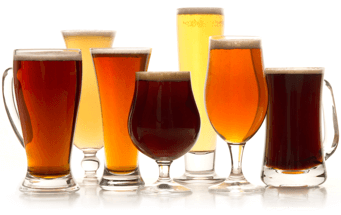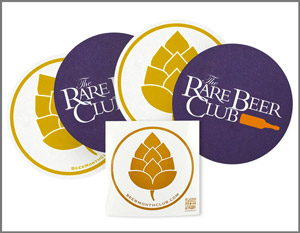Dogfish Head - Burton Baton
-
ABV:
11% -
Malts:
Pilsner, Crystal, Amber -
Hops:
Warrior and Glacier
This is a quiet room, probably the only quiet room, in one of America's, and one of the world's, biggest brewpubs called Wynkoop. It's on Wynkoop Street in Denver in the area that used to be called the warehouse district, but is now called LoDo, Lower Downtown. There's been a phenomenal transformation in this area. It's gone from being a NoGo area to being the fashionable LoDo area full of bars and restaurants, and life and activity. And the person who sparked this almost magical change is a man named John Hickenlooper. John was a young guy in his 30's working in the oil industry, and that industry took a dive and John was let go. He was out of a job. And in a time-honored American way, he picked himself up by his bootstraps, raised some money, and said, you know, there are all these warehouses down in the warehouse district that are doing nothing. I could take over one of those places, put a brewery in there, make it into a brewpub. And he did this with huge success. In fact, so successful that he was asked by potential partners in a number of other cities in this part of the country, cities in the prairies and the Midwest, to work similar magic there. And he was involved, to my recollection, in setting up breweries in the warehouse district of Oklahoma City, as well as Omaha, Nebraska, Des Moines, Iowa, and many other cities.
It was a case of beer refreshing parts of cities that had died, and bringing back a new vibrancy to them. A wonderfully good thing for the civic health of those cities, and of course the place that he achieved the most was right here in Denver.
There was another famous brewery in the United States that made an India Pale Ale; it also made a special Christmas beer called Burton Ale. And that's something that's quite close to the hearts of many American beer lovers and brewers. One of the most passionate, some think crazy, brewers in the United States is Sam Calagione. Sam has just made a beer that is a tribute to all of those things; it's a tribute to the town of Burton, a tribute to India Pale Ales, and a tribute to the once great Burton Ale made by Ballantine on the east coast.
The word Burton crops up a lot in beer labeling and the world of brewing. What does that mean? Well, Burton is a rather scruffy little town in the middle of England, but is the brewing capital of England. It's the town where Bass is, for example. There are three breweries in the town, and it's the town where India Pale Ale was first brewed. It was actually brewed by a big brewery, but the brewer used a wash copper the first time around to do his experimental version of it.
India Pale Ale was the ale that was sent to the British Empire, to the administrators in Calcutta, who wanted to have a British style of beer. And because they had to send it around Cape Horn in sailing vessels, in clippers, on a long journey through a lot of changes in temperature, they put a whole lot of hops in that beer. They made it very, very hoppy, because hops protect beer from spoilage. So India Pale Ale from Burton became a famous style.
MJ - So, why did you do this? What gave you the idea?
SC - I got the word from your camp that you guys were interested in having us do a beer for the club, and I recognized how special of an opportunity that was. I wanted to brew something extremely special that celebrated both your native country and mine, and I figured the Burton legacy is actually one that spans both continents, and has relevance to both of our beer heritages. So that's where I started for the beer.
MJ - You also brought together the cultures of the two countries in your labeling.
SC - Yes, I did. The label here is by an artist that's very dear to my heart, a fellow named John Langford, who was named the Village Voice's Artist of the Year in 2003. He does great, really rustic work that represents our rustic, full-bodied ales very well, but more than that, his musical history spans both continents, as well. He currently plays in a band out of Chicago called The Waco Brothers, but his roots are with a UK-based punk band called the Mekons, which is one of the proto-punk bands. And it's really kind of a testament to you, as far as the beer industry. What you've accomplished is very punk-rock ethos, in my thinking.
MJ - I've always thought of it as more bebop.
SC - In history, he's the equivalent to bebop - he's the Charlie Parker of punk rock in that he wasn't willing to just accept the status quo, and he said, "This is what music can be," in the same way that you said that beers can be every bit as rich in character, and have as much depth and pair as well with food as any wine that's ever been made.
MJ - And just to confuse the cultural references further, he looks a bit like Woody Guthrie, doesn't he?
SC - He does. Of course, Woody Guthrie's got a fond place in my heart. You came and visited when I did my little Woody Guthrie channeling at the White Horse in London, and Woody Guthrie is I think in the same spirit as you are, and that I aspire to, which is to cut your own path in the world, and if it's worthwhile, the world will meet you at your doorstep.
MJ - I used to love listening to Woody Guthrie singing that song about Washington and Oregon.
SC - Oh yeah, and he got paid by the dam company to write that.
MJ - You know, when I was a kid, I never knew where Oregon was. I never knew I was going to spend so much time in Oregon tasting hoppy beers there too.
SC - That's one of the places it started, speaking of hoppy beers.
MJ - Absolutely. But you've come back from the east coast, and started doing some pretty heavy hopping there.
SC - This beer is certainly kind of a "shout-out" to east coast IPA heritage. In this generation of American breweries, everyone's very quick to give Sierra Nevada the pops, and they certainly deserve them, and the whole lineage including Rogue and Stone and a number of great west coast IPAs; that recognition is certainly fueled by the fact that the west coast, Oregon, as you mentioned, Washington, is the breadbasket of hops in America today. But I don't want people to forget that the original gangster IPA was being made by Ballantine's in the 50's and 60's and that their Burton Ale was so special that they released it once a year and like our beer, it was a blend of different batches that was aged in wood for complexity. I even heard rumors that some years it came out so great they refused to sell it, and only gave it to their favorite and most treasured customers, which is where I thought the demographic of the people involved in this club would be - fellow champions of really special beers.
MJ - I don't remember quite when the brewery closed, but the one time I tasted Burton Ale from Ballantine's was at Fritz Maytag's vineyard. That was back in the 70's, before Fritz had launched Liberty Ale, another of California's entries in the hop head contest. You've made some very hoppy beers like the 90 Minute IPA, and you did another one after that, 120 Minute IPA. I find it difficult to keep track with you.
SC - I'm a happily unmedicated ADD sufferer.
MJ - What's the difference between this beer and things like 120 IPA?
SC - It's a little bit softer and rounder and has some more depth than our 90, although it's very close in alcohol content. Our whole theory between our 60 and 90 and 120 is that everything's proportionate: 6 percent alcohol, 9 percent; 20 percent - 60 IBUs, 90 IBUs, 120. With this, what we did was brew a beer that was a little bit stronger than our 90 - about 10 percent alcohol Imperial IPA. We fermented it; we did our continual hopping method where we add hops from the second we start boiling to the end. It is aged on dry hops. And then after that period, we pumped it into a horizontal tank, where we actually cut up barrels, French oak staves, and just sterilized the oak staves. We shoved bundles and bundles of oak staves into the tank, then add the beer and let the wood work for 4 or 5 months. And we waited until a couple weeks before the bottling before we blended that oak aged IPA with a fresh batch of our 90. So it's kind of the best of both worlds, with an aged beer and a fresher blended beer.
MJ - You know I hope that people hearing you talking are picking up what a true craft brewer you are. I think it's frustrating for all of us to hear the bad rap that beer often gets; that it's some industrial product made by barons who are out to ruin our youth - I mean, it's obviously ruined your youth; it certainly ruined mine. You know, even when you think about the Victorian brewers and their counterparts in this country, you know that Pabst built the theater in Milwaukee, for example. Vassar was a brewer who financed that college for all those nice ladies. Sitting here, tasting your beer in the Wynkoop Brewpub in Denver, which is probably more of a beer capital today than Milwaukee.
SC - It's a mecca and we're here on our annual pilgrimage, aren't we?
MJ - The Great American Beer Festival. You know, I get so frustrated when people say to me, "Late September, you'll be going to the Oktoberfest in Munich, won't you?" You couldn't pay me to go the Oktoberfest. It's not a beer festival. A festival with 6 beers is a beer festival? You've got 2000 beers at the Great American Beer Festival. All American, that's fantastic. And that has been brought about by the craft beer movement in the United States. And the beers are so much more interesting in the United States.
Of course I get beaten up in Europe for saying this, but what you're doing with these beers is a true return to craft brewing. It's really beyond what craft brewing ever was. And we're talking about the more philanthropic or more civically minded aspects of the brewing industry -- this brewpub in the warehouse district of Denver, which they now call LoDo, was kind of called NoGo. I used to come here to listen to jazz at El Chapultapec. People would say, "You'll get killed going down there, it's a dangerous area."
When John Hickenlooper opened this place, he really paved the way for the revival of this whole neighborhood. And he consulted for breweries in other cities, did the same thing in other cities, and really brought life back to cities and in this case, the whole of Denver sort of coalesced once LoDo got going. He's the mayor now. Isn't that great? Here's to his honor Hickenlooper.
SC - Yes, to his honor.
MJ - Are there any herbs or spices in this beer?
SC - No, this is one of our rare, almost Rheinheitsgebot beers other than the oak, which our federal government asked me to divulge more information on before they gave me label approval. I guess oak isn't an accepted ingredient in traditional beer in our country, I found out after I submitted my label. For wine it's fantastic, they won't bat an eye if you submit a label for wine, which I guess shows you just how much bias there is even federally against beer being considered in the same way as wine is.
MJ - I asked you about the herbs because there's a slightly tobacco-like aroma; you also get that from Tettnang hops, but I don't think you used Tettnang hops.
SC - No, but it does have some Warrior in it, which is a fairly spicy hop, and then I think the oak's contributing a little bit to the spiciness, certainly the earthiness of the beer. Do you get much of a wood character in it right now?
MJ - Famously, of course, oak gives you vanilla flavors from the vanillin, which is part of the make-up of the oak, but very often oak reminds me of cedar. They're completely different woods, but it's that sort of spiciness, it's that sort of cigar box character. If you found that kind of character in what the British call a claret from Bordeaux, especially if it's from the region of Pauillac, you would say it was a classic first growth claret. I'm surprised it's not more winey tasting, really, but it's a beautifully composed beer. The heavy maltiness isn't at all cloying; the hefty hoppiness balances it, but it doesn't smack you in the mouth. It has these oaky, spicy characteristics.
SC - It's as malty of an IPA as it can be, considering it's so IBU intensive.
MJ - IBU is international bittering units. I just wrote a piece for the Italian edition of Slow Foods magazine called "Beautiful Bitterness." And I was trying to play around with the idea of why the word bitter sounds negative. Yet the Italians love to drink a bitters before a meal. And you know, we like to drink a very bitter beer. Bitterness is, for real beer freaks, a very positive thing and obviously sometimes you hear brewers talking about units of bitterness in their beers. It's a sort of contest that men get involved in.
SC - Right, and it's irrelevant; anyone can add a little bit of beer to their hops and make an extremely hoppy beer.
MJ - It's a very complex beer and I'm just wondering what food I'd like to have with it. I'm not quite sure yet. I'm sort of thinking in terms of game or bleu cheese.
SC - Smoky, big flavors. It would stand up to them, wouldn't it?
MJ - It would. I would love to marinate some prime rib or something in this beer. It seems rather extravagant. People cook with wines that are regarded as not being good enough to drink. If they're not good enough to drink, they're not good enough to eat. Maybe in the spicier area, maybe goulash, or something like Hungarian food. I think people are going to love this.
SC - Well I hope so. I love it, and our brewers love it, and that says so much because our brewers have extremely exacting standards and they're very anxious and proud to be brewing this beer for the club. They are definitely excited, too.

Unmatched Variety by style, brewery & country
Choose from Five different Beer Clubs offering unmatched variety by brewery,
country of origin, and beer style to suit your specific tastes.


